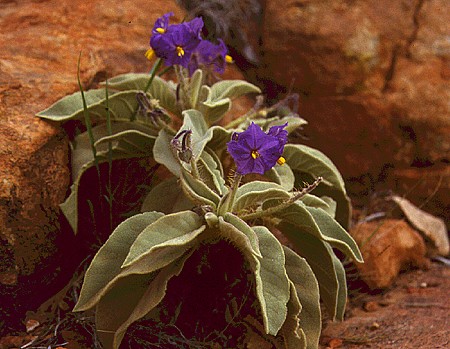
Synonymy
Solanum quadriloculatum F. Muell., Fragm. Phytogr. Austral. 2: 161 (1861)
T:
S. ellipticum var. duribaccalis J. Black, Trans. & Proc. Roy. Soc. S. Austral. 52: 227 (1928), fide J.M. Black, Trans. & Proc. Roy. Soc. S. Austral. 58: 181 (1934).
T: none cited or traced.
[Black (1928) actually described two new varieties of S. ellipticum , var. mollibaccalis and var. duribaccalis which he distinguished by their fruits, one soft juicy and purplish and edible (mollibaccalis), the other yellow and not edible (duribaccalis). He did this because he did not know the nature of the fruits of the type of S. ellipticum , collected by Robert Brown from Broad Sound in Queensland. Var. mollibaccalis is now considered to be a synonym of S. ellipticum while var. duribaccalis is treated here. Black later (Black 1934) withdrew the two varieties, recognising his earlier mistaken determination of the Koch collection, which he then cited as part of S. quadriloculatum. This Koch collection from Mt Lyndhurst in the Tate Herbarium, is the obvious choice as type. rmb]
S. crassitomentosum Domin, Biblioth. Bot. 89: 584 (1929). This species, treated here as a synonym by Symon (1981) is treated as distinct by Bean - see S. crassitomentosum .
Description
Erect or sprawling, sparingly clonal shrub to 50 cm, grey-green or yellowish-green, densely pubescent with stellate hairs, sometimes scabrous; prickles to 6 mm long, abundant on stems, petioles, peduncles and calyx, sparse or absent elsewhere.
Leaves ovate-elliptic; lamina mostly 5–9 cm long 1.5–4 cm wide, sometimes larger, entire to slightly undulate; petiole 1–4 cm long.
Inflorescence up to 20–flowered; peduncle 15–20 mm long; rachis to 8 cm long; pedicels 5–10 mm long. Calyx 6–10 mm long; lobes narrowly triangular, 4–6 mm long. Corolla stellate or pentagonal, 20–25 mm diam., purple. Anthers 4–6 mm long.
Berry globular or depressed globular, 10–15 mm diam., light yellow-brown, finally hard and bony. Seeds 2–3 mm long, pale mustard-yellow to light grey. n=12.
A DELTA-generated description of this species by Bean can be seen at http://delta-intkey.com/solanum/www/quadrilo.htm
Distribution and ecology
There is a problem with differing circumscription here. Earlier treatments (Symon 1981, Purdie et al. 1982) considered this species to be widespread in arid regions, extending from north-eastern W.A. through N.T. and S.A. to western Qld and north-western N.S.W. It was documented as being common on undulating plains, levee banks of seasonally flooded water courses, or flood-out plains.
Bean (2004) only gives the distribution as northern Australia and it is not entirely clear just where he considers the rest of the specimens of S. quadriloculatum from arid Australia, treated by Symon (1981) and Purdie et al. (1982), to belong; it has been assumed here that he considers them to belong within S. ellipticum .
Common name
Wild tomato. Note however that this species is poisonous and its common name could easily be misleading to the unwary.
Relationships
Part of the S. ellipticum group of subgen. Leptostemonum according to Bean (2004).
Notes
Bean's circumscription of this species apparently differs from that of Symon since his distribution statement does not mention the South Australian and New South Wales occurrences of Symon; he appears to confine the species to northern areas of Australia and only to the Burke and Gregory North Districts in Queensland, whereas Symon recorded the species from the Chillagoe area (based on Symon 4784). Just what Bean considers the Symon specimen to be is not clear as it appears not to be cited under any of the other species in the S. ellipticum group and misapplications are not dealt with exhaustively in the Bean work.
In his account of S. quadriloculatum in central
Reported to be toxic to sheep in
Selected specimens
N.T.: Palm Valley, 21 July 1954, G.M. Chippendale (AD, CANB, NT). S.A.: Paralana Springs, D.E. Symon 6004 (AD). Qld: 80 km SE of Camooweal, S.L. Everist 3381 (BRI). N.S.W.: c. 16 km S of White Cliffs, J.H. Leigh W216 (NSW).
Plant status, if any
Conservation status as a plant of least concern in the
From the web
Further information for S. quadriloculatum can be found on the FloraBase site for WA, on the PlantNET site for NSW and on the eFlora site for SA.
Images of this species at the Birds Australia Newhaven Reserve can be seen on the Blue Gum Pictures site.
Further information and links for this species can be found on the Solanaceae Source site.

